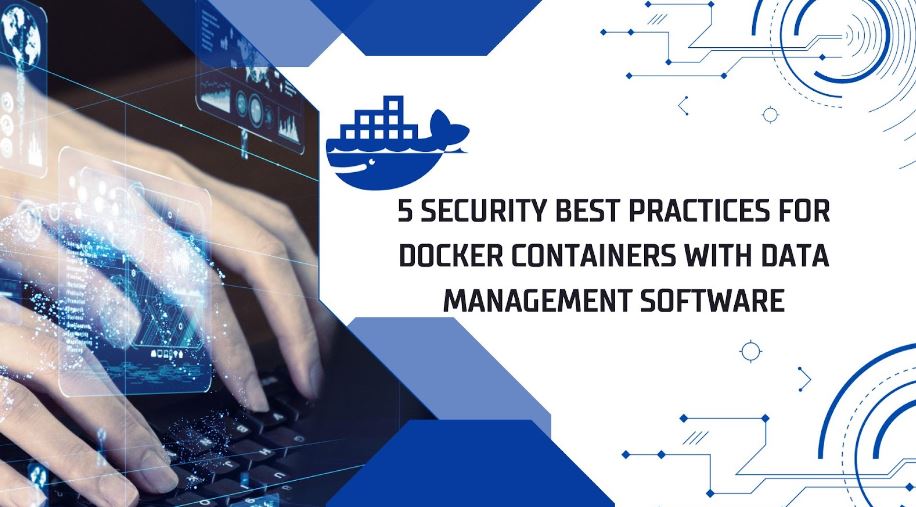Docker containers provide a convenient way to deploy data management software. However, securing containers running sensitive data workloads requires careful configuration. Docker’s lightweight container technology has become popular for running all types of applications, including databases, data pipelines, analytics tools, and other data management software.
According to Docker’s 2021 survey, 49% of application containers hold sensitive data. However, securing data within containers presents challenges:
-
Data management software often requires access to mount points, volumes, filesystems, and networks.
-
Containers run with shared access to the underlying host kernel.
-
Images may contain sensitive data like credentials or configuration details.
In this article, we will provide security best practices for Docker deployments running data management software across areas like the Docker daemon, images, container runtime, and networking. Properly securing containers will help reduce the risk of data breaches.
What Is Docker & Why Is Image Security Important?
Docker is an open-source platform used for developing, shipping, and running applications within containers. Containers package an application’s code together with all dependencies such as libraries, binaries, and configuration files.
This allows the application to run quickly and reliably from one computing environment to another. Docker containers share the host system’s OS kernel but run in isolation from one another.
Securing Docker images is critical because:
-
Images form the foundation for containers at runtime. Vulnerabilities in images can lead to compromise of containers and hosts.
-
Images are often built from base images or shared across projects and teams. Flaws can therefore propagate widely.
-
Containers share the host kernel and can access resources on the host system if not properly isolated.
Overall, container security relies heavily on the security of images. Securing images should be a priority.
Key Docker Security Challenges for Data Containers
Running data management software in Docker containers introduces some key security challenges:
-
Containers often need broad access to filesystems and volumes to persist and share data. This expands the attack surface.
-
Sensitive credentials need to be securely injected into containers at runtime. Hardcoding secrets in images is very risky.
-
Network segmentation is critical for isolating different data services, but can be complex to configure correctly.
-
Containers running multiple data services increase the risk of lateral movement if one service is compromised.
-
Compliance requirements may dictate encryption, rigorous access controls, and auditing capabilities not native to Docker.
Best Practices for Securing Data Containers
Docker containers provide some inherent security advantages over regular virtual machines. One essential aspect that complements these advantages is adhering to test data management best practices. Ensuring that these best practices are in place not only fortifies the security but also streamlines the data handling process within the containers.
This holistic approach to security and data management positions Docker containers as a robust solution for modern software deployment and testing scenarios. By integrating test data management best practices, developers can minimize the risk of exposing sensitive information and ensure that data remains consistent across different testing environments.
Docker Daemon Security
-
Restrict daemon access to specific users via TLS mutual authentication and certificates.
-
Integrate the daemon with your OS authorization framework using SELinux, AppArmor, etc.
-
Monitor daemon activity closely using tools like Falco to detect anomalous behavior.
Docker Image Security
-
Ensure base images have minimal packages installed and come from trusted sources.
-
Never store actual data within images, only necessary configuration.
-
Scan images during the build for vulnerabilities using Trivy, Anchore, or similar tools.
-
Sign images via Docker Content Trust and enable image verification before deployment.
Container Runtime Security
-
Leverage Docker security profiles to restrict container capabilities based on the principle of least privilege.
-
Prevent container escape to host using namespaces, control groups, and additional SELinux/AppArmor policies.
-
Employ strict resource limits on containers via control groups.
-
Mask sensitive mount points like /proc to limit host access.
Secrets Management
-
Avoid baking secrets into images. Pass them in securely at runtime via tools like HashiCorp Vault, AWS Secrets Manager, etc.
-
Integrate secrets management with your identity provider like Active Directory, Okta, and Auth0 for access controls.
-
Rotate secrets periodically.
Network Security
-
Place data services in separate container networks with firewall policies restricting inter-network access.
-
Disable inter-container communication between containers holding different data.
-
Route outbound traffic from containers through proxies, firewalls, and VPNs. Do not allow direct internet access.
-
Integrate Docker networks with existing corporate virtual networks and security groups.
Security Limitations of Docker Containers
However, containers also present some security challenges:
-
The host kernel is shared between containers and could be vulnerable to container escapes.
-
Containers by default have access to host system calls and resources. Access must be properly restricted.
-
Images may contain vulnerabilities that get propagated between builds. Maintaining secure base images is critical.
-
Secrets management remains challenging – securely injecting secrets into containers at runtime.
-
Monitoring and restricting container communications can be difficult with overlay networks.
Overall, containers do provide security advantages if configured properly. However, like any technology, they also introduce new risks that must be managed.
Security Advantages of Docker Containers
-
Lightweight and immutable infrastructure: Containers share the host kernel and do not require an OS per application. This reduces the attack surface and limits areas for security exploits. Containers are easily created, destroyed, and replaced with new instances.
-
Isolation between containers: Containers isolate applications from each other via kernel namespaces and control groups. This limits damage if one container is compromised.
-
Application-centric security: Security policies and controls can focus on securing the application rather than the entire OS. Images can be scanned for vulnerabilities during the build.
-
Principle of least privilege: Containers can restrict root access and run with only the necessary resources and privileges allocated. This reduces the attack surface.
-
An ecosystem of tools: The container ecosystem provides many tools for vulnerability management, monitoring, runtime security, secrets management, and network segmentation.
Additional Capabilities for Enhanced Data Security
Some additional capabilities can further lock down and monitor data containers:
-
Whole-disk and volume encryption to protect data at rest outside containers.
-
Security-focused operating systems like Tails Linux to harden the container environment.
-
IDS/IPS monitoring of container network traffic to detect threats.
-
Fine-grained controls on data access are provided by tools like Sysdig Falco.
-
It is integrating Docker with data security platforms that provide unified policy enforcement, auditing, and compliance reporting.
Final Thoughts
Containers running sensitive data management workloads require stringent security measures to avoid breaches. Locking down daemon access, building secure images, hardening runtime settings, managing secrets carefully, and network segmentation are essential starting points.
Additional Linux security modules, encryption, activity monitoring, and advanced data security platforms can further enhance protections. With vigilant security across all aspects of the container environment, companies can safely unlock the benefits of Docker for their data services.
FAQs
1. Should I encrypt data volumes attached to containers?
Encrypting volumes is highly recommended to protect data at rest outside the container. Make sure proper access controls are still in place.
2. What’s the most effective way to isolate data services from each other in Docker?
Putting services into separate container networks with restricted access between networks. Also, limit the sharing of volumes between containers.
3. How can I monitor and audit activity on sensitive data within containers?
Tools like Sysdig Falco allow capturing system calls and logging container activity. Integrating with an SIEM provides additional auditing and alerting.
4. Do I still need antivirus software if running data solutions in Docker?
Antivirus is less critical given container isolation. However, some solutions provide AV scanning specifically for containers to detect malware.



